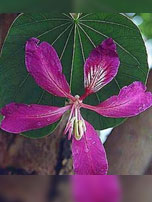SHAHEED KARTAR SINGH SARABHA AYURVEDIC MEDICAL COLLEGE & HOSPITAL
Affiliated to Guru Ravidas Ayurved University, Hoshiarpur Punjab
Affiliated to Guru Ravidas Ayurved University, Hoshiarpur Punjab

Botanical Name : Bauhinia variegata Linn
Family : Caesalpiniaceae
Introduction :
Kovidãra is the original name using for Kãñcanãra during the Vedic and Samhita periods. It show its action on lymphadenitis. Along with other therapeutic applications, The Ayurvedic Pharmacopoeia of India indicated the use of the stem bark in lymphadenitis and goiter.
Names in different Indian languages :
English : Mountain Ebony,Buddhist Bauhinia
Hindi : Kancanar
Kannada : Kempumandara
Malayalam : Mandaram,chuvanna mandaram, malayakatti,konnu
Sanskrit : Kancanarah,kovidarah
Tamil : Singappu mandarai
Telugu: Devakancanamu
Marathi : Koral
Synonyms :
Gandãri, sonapuspaka ,Kaanchanaara, Kaanchanaaraka, Kanchanak, Kaanchana, Gandhaari, Sonapushpaka, Ashmantaka.
B. candida Roxb
Varieties & adulterants – (CV – controversy, AD – adulterants) :
Note: The latin names kancanara given to, According to
Dhanvantarinighantu – B. purpurea
Rajanighantu- B. acuminata
Bhavaprakasam- B. variegate
Reference from Ayurvedic formulary of India kovidara – B. variegate
Reference from Indian Medicinal Plants kancanara – B. tomentosa, sveta kancanara- B. racemosa
1.Kovidãra
2. Karbudãra
3.Pita,
4.Rakta
5.Sveta.
6. yellow flowers – B. tomentosa.
7.B. variegate
8. olax scandens
Morphology :
It is a medium sized erect and deciduous tree.
Bark- grey with longitudinal cracks, light-pink inside.
Wood- moderately hard, greyish-brown.
Leaves- unifoliolate, 2-lobed, rigidly subcoriaceous, deeply cordate.
Flowers- purple or variously coloured, sessile or borne in short penducled corymbs. Calxy-tube elongated; limb entire, spathaceous.
Fruits- pods, flat, hard, long, curved, compressed, dehiscent.
Seeds 10-15.
(Flowers in March and fruits in rainy season).
Distribution & Habitat :
In the sub-Himalayan tract from the Indus east wards; also in dry forests of central, Easterm and Southern India
Chemical constituents :
flavonoids, kaempferol,galactoside and kaempferol,rhamnoglucoside,hentriacontane, octacosanol ,stigmasterol,beta-sitosterol, lupeol and a flavanone glycoside
Properties :
Rasa- Kasãya
Guna- Rüksa, Laghu
Virya-Sita
Vipãka -Katu
Karma : Kapha-pittahara, Grãhi, Dipana.
Buds—a decoction is given in piles (also used against tumours), haematuria, menorrhagia.
Dried buds are used in diarrhoea, dysentery, worm infestation, piles and tumours.
Root—carminative, used in dyspepsia and flatulence
Bark—astringent, anthelmintic; used externally in scrofula and skin diseases.
Seeds—possess human blood agglutinating activity.
Leaf— antifungal.
Indications :
Gandamãlã, Rakta pradara, Raktapitta Mutrakrcchra, Vrana, Arsas, Musürikã
Diarrhea,dysentery, leprosy, worms,wounds,ulcer,asthma,piles,menorrhadia, goiter
Part Used :
Stem bark, flowers
Dosage :
Powder 3-6 g;
decoction 50-100 ml;
flower juice 10-20 ml.
External Uses :
It helps in wound cleaning and healing – it cures skin disorders and inflammations. Decoction is used for washing wounds and skin disorders, The bark ground in a paste is useful in lymphadenitis. Decoction made from its bark, pods of babul (Acacia) tree and flowers of pomegranate is used for gargles in oral disorders. Decoction is used for fomentation in rectal prolapse.
Internal Uses :
Digestive system : It has astringent , it causes vomiting in excess dose. Being sweet flowers are mild laxative. Astringent properly is useful in diarrhea, dysentery, rectal prolapse, haemorrhoids and helminthiasis. It enhances emetic action when used in conjunction with emetic drugs.
Circulatory system : It acts as haemostatic and reduces the inflammation of the lymph nodes (lymphadenitis). It is effective in hemorrhoid disorders.
Respiratory system : Used in cough
Urinary system : Controls diabetes.
Reproductive system : it acts as a haemostatic be astringent property
Skin : Used in skin diseases Mixture of kanchanara bark, rice water, and ginger is effective in osteoporosis
Srotogamitva :
Dosa : Kaphaghna, pittaghna.
Dhatu : Rakta, meda , menorrhagia, haemorrhagic disorders.
Mala : Purisha – Atisagham
Important Yogas or Formulations :
Kanchanara guggul, Kanchanaradi kwath, Kanchan gudika, kashaya
Therapeutic Uses :
(1) Gandamãlã- Fresh bark of Kãñcanãra is grinded with
sunthi and Kãnjika and used internally (V. M.).
(2) Masürikã- Svarnamãkika bhasma is given with decoction of Kãncanãra bark (B. P.)
